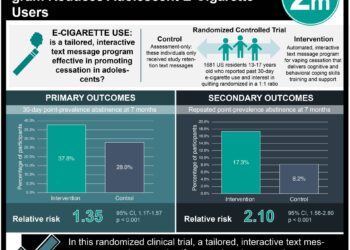Accessibility, social norms associated with continued e-cigarette use among youth
1. Middle and high school students’ e-cigarette initiation, continued use, and their reasons for smoking were prospectively examined. The ability to use e-cigarettes anywhere and trying to quit traditional cigarettes were reasons associated with continued e-cigarette use.
2. Youth who initiated e-cigarette use at a younger age and those who concomitantly smoked traditional cigarettes were more likely to continue using e-cigarettes.
Evidence Rating Level: 2 (Good)
Study Rundown: E-cigarettes have become an increasingly popular tobacco product. It remains unclear whether e-cigarettes capture youth at low risk for smoking traditional cigarettes, therefore increasing tobacco use, or they serve to aid current smokers in their efforts to quit. Equally significant is the lack of data on the long-term health effects of e-cigarette use, necessitating the prevention of use among young people until consequences are better understood. Regardless, the use of e-cigarettes among high school and middle school youth tripled from 2013 to 2014. This study builds on previous research exploring factors that predict e-cigarette use among youth. Middle and high school students were surveyed over 2 time periods, and asked about use patterns and reasons for trying e-cigarettes. Overall, the ability to use e-cigarettes anywhere and quitting traditional cigarettes were reasons that predicted continued e-cigarette use over the studied period. Using e-cigarettes because of low cost was associated with the most frequent e-cigarette use during the follow-up period. Youth initiating e-cigarettes at a younger age, or those who were current traditional smokers were also more likely to continue using e-cigarettes. Regulatory strategies aimed at decreasing continued e-cigarette use among youth may incorporate these findings into cost-increasing and use-prohibiting policies. While this study has major policy implications, it is limited by the lack of generalizability.
Click to read the study published today in Pediatrics
Relevant Reading: Early smoking onset may promise initial pleasurable sensations and later addiction
Study Author, Dr. Krysten W. Bold, PhD, talks to 2 Minute Medicine: Yale School of Medicine, Department of Psychiatry, New Haven, Connecticut
“Our findings show that youth who report first trying e-cigarettes because they can be used anywhere or to quit smoking regular cigarettes were more likely to continue e-cigarette use 6 months later, and youth who said they tried e-cigarettes because of low cost were using e-cigarettes on more days 6 months later. The study also concluded that younger students and current cigarette smokers were more likely to continue using e-cigarettes over time, and suggests that campaigns to prevent continued use be targeted at younger students.”
In-Depth [prospective cohort]: This study surveyed 2 middle schools and 3 high schools in 2 time periods, fall 2013 (wave 1) and spring 2014 (wave 2). Surveys were matched across time using a unique code for each subject, and only e-cigarette ever-users were included in the sample (n= 340, mean age 15.6 +/- 1.2 years). Ever-users in wave 1 reported their reasons for trying e-cigarettes from a variety of provided answers including “low cost,” “can hide from adults,” “good flavors,” “curiosity,” “can use anywhere,” “to quit smoking cigarettes,” etc. In wave 2, youth were asked how often they used e-cigarettes in the past 30 days. Using multivariable modeling, the strongest predictor of continued e-cigarette use was to quit traditional smoking (adjusted OR= 14.54, 95%CI: 180-117.8). The strongest predictor of more frequent e-cigarette use in wave 2 was citing low cost for initiating use in wave 1 (β = .36, p ≤ .01), followed by quitting smoking (β = .28, p ≤ .01) and ability to use e-cigarettes anywhere (β = .30, p ≤ .01). Middle school students and traditional cigarette smokers were more likely to use e-cigarettes in wave 2, compared to their high school, non-smoking counterparts (OR 2.86, 95%CI: 1.01-8.13 and OR 2.07, 95%CI: 1.12-3.82, respectively).
Image: CC/Wiki/LindsayFox
©2016 2 Minute Medicine, Inc. All rights reserved. No works may be reproduced without expressed written consent from 2 Minute Medicine, Inc. Inquire about licensing here. No article should be construed as medical advice and is not intended as such by the authors or by 2 Minute Medicine, Inc.







